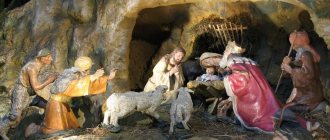Answer to the question
Photo: Monastir58.ru
The Holy Trinity is a term meaning that God is one in 3 incarnations, persons. God is undivided, but threefold. The word “Trinity” itself, of non-biblical origin, was introduced into the Christian lexicon in the second half of the 2nd century by St. Theophilus of Antioch. The doctrine of the Holy Trinity is given in Christian Revelation. The dogma itself is incomprehensible if you look at it from the point of view of ordinary everyday logic. This treatise is considered the most mysterious, open only to a select few. No wonder Fr. Pavel Florensky called it “the cross of human thought.”
Just as the sun emits light, heat and invisible radiation at the same time, so the Lord has 3 hypostases that are simply impossible to know. The Feast of the Holy Trinity is celebrated on the 50th day of Easter, which falls at a different time every year. On this day, the Day of the Holy Spirit is also celebrated, when greenery is brought to churches, which then sanctifies the house.
SECTION II ABOUT GOD, THE TRINITY IN PERSONS
The Nicene-Constantinople Creed confesses faith in the Holy Spirit, “who proceeds from the Father.” Roman Catholics insert “and the Son (Filioque)” into the text of the eighth article of the Creed. Thus, this member of the Symbol takes on the form: “it comes from the Father and the Son” (Patre Filioque procedit).
The foundations of this teaching were laid by Blessed. Augustine, whose triadology differed significantly from the Trinitarian teaching of the Eastern fathers of the 4th century. and had a decisive influence on the subsequent development of Western Trinitarian theology.
In his reflections on the Trinity, Blessed. Augustine does not proceed from the contemplation of the trinity of Persons, but from the idea of the unity of the absolutely simple Divine essence501, which manifests itself in the Three Divine Persons502. At the same time, Persons are thought of as blessed. Augustine as a certain system of intra-essential relations that differentiate the essence503, to understand which a person must turn to the inner world of his own soul, created in the image of God504. Bliss in the human soul. Augustine sees the trinity of memory, thinking and will505. He transfers this psychological analogy from the image to the Prototype and thinks of the relationship of Divine Persons in the image of the relationship of memory, thinking and will in man: Memory, or Mind (Father), Thinking, or Knowledge (Son), Will (Holy Spirit)506. Since the will is most fully expressed in love, the third member in this formula, instead of Will, can be Love507. Just as in man love (will) is born from the depths of his spirit, or memory, providing a connection between memory and thinking508, so in God the Holy Spirit initially and primarily (principaliter) comes from the Father, but at the same time from the Son (de Filio)509 , and there is mutual Love of the Father and the Son510.
At the same time, blessed Augustine considers it unacceptable to say that the Holy Spirit has two causes of His procession, and teaches about the procession of the Spirit from the Father and the Son as from a single cause: “The Father and the Son are one principle of the Holy Spirit, and not two principles. After all, just as the Father and the Son are one God, and in relation to creation there is one Creator and Lord, so in relation to the Holy Spirit They are one principle. In relation to creation, the Father, Son and Holy Spirit are one principle, just as there is one Creator and Lord.”511
However, filioquist statements are found among blessed. Augustine only in his treatise “On the Trinity”. His other works contain statements that are a direct denial of the doctrine of the double procession of the Holy Spirit: “We call Him neither Son nor Father, but precisely the Holy Spirit... The Holy Spirit is not born of the Father, like the Son... is not from the Son, like the grandson the Supreme Father, but [we teach] that He owes everything that He is to no one except the Father, from Whom are all things, so as not to allow us two principles without a beginning (duo... principia sine principio), which is completely false and absurd and characteristic not of the Catholic faith, but of the error of some heretics.”512
Thanks to the high authority of the Bishop of Ippon in the Christian West in the early Middle Ages, the doctrine of the double procession of the Holy Spirit began to gradually spread. Already at the beginning of the 6th century. At the council in Toledo (Spain), an attempt was made to introduce the Filioque into the text of the Nicene-Constantinople Creed. Apparently, the Spanish bishops, considering the doctrine of the double procession as an argument in polemics with the Arians and Visigoths, tried to use it to emphasize the idea of the consubstantiality of the Father and the Son. The Filioque became widespread in the 9th century thanks to the activities of Emperor Charlemagne, who instilled this Trinitarian doctrine within his empire. The popes for a long time were opposed to inserting the Filioque into the text of the Creed. Thus, Pope Leo III (795–816) not only refused to comply with Charles’ demand, but, wanting to prevent in the future the possibility of distortion of the Nicene-Constantinopolitan Creed, he ordered the text of the Creed to be cut out without the Filioque on two silver tablets - in Greek and Latin - and placed them next to the tombs of St. Apostles Peter and Paul, accompanied by the inscription: “I, Pope Leo, did this out of love for the Orthodox faith and for the sake of preserving it.” At the beginning of the 11th century. Rome and the papal throne were at the mercy of the German emperor. In 1014, Emperor Henry I, driven by anti-Byzantine sentiments, managed to force Pope Benedict VIII to include the Filioque in the Creed 513. The Council of Bari (1098), presided over by Pope Urban II, declared all those who do not share the doctrine of the Filioque to be heretics . This doctrine was finally formulated and dogmatized by the Catholic Church in 1438 at the Council of Ferraro-Florence514.
In the East, the doctrine of the double procession of the Holy Spirit had no adherents. A thorough criticism of the doctrine of the Filioque was first given by St. Photius of Constantinople515.
The Latin doctrine of the double procession of the Holy Spirit (from both, Latin ab utroque) should be distinguished from the statements of some Eastern Fathers, according to which the Holy Spirit proceeds from the Father through the Son (Greek διὰ Υἱοῦ; Latin per Filium). Such expressions can take two forms:
1) some speak not about the eternal procession, but about the embassy of the Holy Spirit into the world accomplished in time by the Son516;
2) others attribute the expression “through the Son” to the timeless plan517. However, this does not give grounds to equate the Filioque with the expression “through the Son.” The Eastern Fathers recognize only the Hypostasis of the Father, from which the eternal procession (ἐκπόρευσις) of the Spirit takes place, as the only hypostatic reason for the existence of the Holy Spirit. As for the “shine” (ἔκλαμψις) of the Holy Spirit through the Son,518 it cannot in any way be understood in the sense of the Holy Spirit receiving His personal existence from the Son, but only in the sense of some manifestation through the Son of the Hypostasis of the Holy Spirit as already existing.
According to V.N. Lossky, “it was the Filioque that was the only dogmatic reason, was the root cause of the separation of East and West; the remaining doctrinal disagreements are only its consequences.”519
Filioquist triadology had “very serious consequences for Western theology. At the public level, the reality of the Holy Trinity quickly lost its meaning and turned into something like a useless philosophical appendage. Many modern Western Christians believe in God the Father, in Christ, but do not have the slightest idea about the Trinity. This does not come from intellectual indifference, but from a deistic understanding of God as a philosophically unified Essence. Perhaps, in the final analysis, these differences between Eastern and Western approaches to the Holy Trinity are more important than even the question of the Filioque
as such"520. In addition, the identification of God with the idea of the Divine essence, established thanks to the Filioque in Western theology, makes it impossible to distinguish in God between His inaccessible essence and His participating actions (energies). As a result, understanding salvation as the real deification of man becomes impossible.
A little about the Creation of the world
Photo: Pravoslavie.ru
In the beginning, God created Heaven and Earth. And the Spirit of God hovered over the water. Before the appearance of Christ, the Spirit of God existed as a continuation of the Creator. Christ turned out to be the son of God, the third incarnation of the Lord who appeared on Earth. The Holy Trinity is one God in three incarnations. He has one nature and 3 self-consciousnesses. It is impossible to understand His essence, but it can be compared with the Sun, which shines brightly and at the same time warms.
Appearance of the term
Photo: Pravlife.org
In the Christian tradition, this term is considered theological. It has become widespread in various faiths, including Orthodoxy. In its essence lies the peculiarity that accompanies each of the personalities included in the Holy Trinity.
Initially, this concept arose in the lexical form “hypostasis”. It originated in Ancient Greece, directly related to philosophy. Translated from Greek, it meant a stand, something standing nearby or some kind of foundation. If we translate the same concept from Latin, then more interesting meanings appear - “existence”, “substance”.
When the term began to be actively used in theology, hypostasis began to be understood as a certain object or a specific person with a pronounced individuality. In this case, an important condition is the presence of an essential principle directly in the person or object.
In everyday perception, the concept of “hypostasis” began to be understood as individual existence. The thinker Plotinus, who adhered to idealism, noted that hypostasis serves as a designation of essence, and at the same time connected the concept with a characteristic of personality.
In Christianity, hypostasis began to be understood as a description of the existence of God in three Persons simultaneously. A clear definition was formulated at the IV Ecumenical Council. It was emphasized that it is worth separating the terms “hypostasis” and “nature,” which illustrated the presence of two essences in the Savior – human and divine.
Gregory the Theologian made his contribution. Together with his followers, he formulated clear distinctions between the terms hypostasis and essence. From his suggestion, the Trinity began to be understood as everything in common, and the hypostasis became exclusively a manifestation of the individuality of each person included in the Trinity, separately.
God the Father
The creator of people, the universe, the beginning began. He is not born, not created, eternal. The Holy Spirit and Jesus Christ (God the Son) are its continuation, incarnation. It is almost impossible to understand and feel this. God the Father knows everything in advance, even the fate of an individual person. Only He knows on what day earthly humanity will end and man will be able to move into the Kingdom of Heaven. Therefore, those who try to predict the end of the world put themselves above God the Father. However, God the Father knows almost everything around everyone. He is the beginning and the end, the highest that exists above us all.
Hypostases of God in the Trinity
Photo: Flickr.com
Basil the Great develops this idea in his works. In the Hypostases of the Lord he sees three images of his existence. Understanding by this not only life in the earthly sense of the word, but also the existence of a person with natural uniqueness.
He emphasizes that, when considering the hypostasis of the Trinity, it is necessary to distinguish between the general and the particular. Thus, the Holy Trinity has a single being, but each individual person has its own exclusively individual characteristics.
Gregory of Nyssa notes that in God there are three different hypostases, but the Lord remains one. Remains a unique entity, despite the fact that its existence is inherent in each individual. He notes in his dogma that the mystery of the relationship of the three persons contained in the Lord is preserved.
God the Son
The earthly incarnation of God, that is, Christ. Unlike the Father, Christ is born. He was ordered to appear on earth to save humanity from many sins. This is the embodiment, on the one hand, of the Divine essence of man, on the other, of God, who appeared to take upon himself the sins of all mankind and give hope for the salvation of generations, both of that time and of those who will then be born until the end of time.
God the Son, unlike the Father, was born of the Virgin Mary. This is the earthly incarnation of God. However, even He obeys the Father. In the prayer “Let this cup pass from me,” Christ knew perfectly well about his death on the cross and about all the suffering that He would have to endure. But, nevertheless, he could not disobey the Father. However, in all the torment there was a certain meaning - Christ lifted the curtain to eternal life, giving the commandments of love in order to be saved and find ourselves in the Kingdom of God for each of us.
Hypostasis of the Savior
Photo: Flickr.com
A lot of controversy and disagreement arose in connection with the heterogeneous nature and essence of Jesus Christ, who simultaneously combined the human and divine principles.
A number of theologians note the existence of a complex hypostasis, specifically regarding Jesus. They note that before the Savior came to earth, his essence was quite simple, since it related to only one nature - the divine.
When the Son of God became incarnate on earth as a man named Jesus, nature became complex because it combined the human and the divine. The uniqueness of the situation was that two natures appeared in one natural hypostasis. However, there is no way to separate them, since they are considered inseparable and therefore true.
The divine and human natures contributed to the formation of the complex personality of the Son of God. However, individual differences remained unchanged. If Jesus Christ accepted death on the cross, then God remained immortal. When the Son of God was a simple hypostasis, he did not have a body. By becoming Jesus Christ, he embodied a complex personality endowed with a dual nature.
Pagan philosophers in their works distinguish two essences - nature and substance. If substance is understood as something common, then nature has its own differences. Capable of having or not having a mind, being immortal or mortal. Thus, they come to the conclusion that all people, as well as animals and even angels, are directly related to nature. At the same time, hypostases have individuality.
Theologians call nature substance, and person - individual. Hypostasis is a substance capable of existing independently, while it can be felt through the senses.











